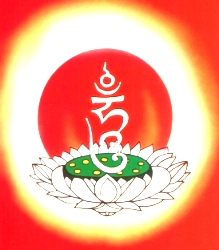

The process is a gradual progression. It is developed through the Shravakayana, Pratyckabudda, Bodhisattvayana and the three outer tantras. Sometimes known as the Father Tantra, Mahayoga is the generative phase of visualising the deity as being luminosity inseparable from great emptiness. By adopting all those outer expressions of the Vajrayana, a wrathful or semi wrathful male deity associated with the transformation of ego, such as those we see in Vajrayana iconography, we cut through our basic duality of good and bad, our basic sense of ego-centered, discriminating mind.
View
This is to realise the inseparability of phenomena and great emptiness. The skilful means to
attain the inseparability of emptiness and form is to envision everything as the pure mandala of
the deities. This is the relative truth.
Meditation
 First we visualize the great space of emptiness, which is the fundamentally pure nature of our
mind, our basic stream of consciousness. Within this space, we visualize a lotus seat,
which symbolizes our pure stream of being. On this lotus seat, we visualize
a sun disk and a moon disk, which symbolize the two reproductive
cells from the father and mother. On the moon disk, we visualize a luminous,
flickering seed syllable, which symbolizes our bardo consciousness.
The flickering seed syllable begins to radiate light, which streams out into
space and then returns, dissolving into the syllable, before radiating out
again, over and over. The process of the light radiating out and returning
represents a process of conception. Through this conception, our consciousness
transforms from the flickering seed syllable into a Vajrayana deity- Vajrasattva.
Thus, we transform ourselves into Vajrasattva, and are born into that realm.
At that very moment, we cut directly through all our ego-clinging and emotional conflicts by
simply taking birth in this pure world.
First we visualize the great space of emptiness, which is the fundamentally pure nature of our
mind, our basic stream of consciousness. Within this space, we visualize a lotus seat,
which symbolizes our pure stream of being. On this lotus seat, we visualize
a sun disk and a moon disk, which symbolize the two reproductive
cells from the father and mother. On the moon disk, we visualize a luminous,
flickering seed syllable, which symbolizes our bardo consciousness.
The flickering seed syllable begins to radiate light, which streams out into
space and then returns, dissolving into the syllable, before radiating out
again, over and over. The process of the light radiating out and returning
represents a process of conception. Through this conception, our consciousness
transforms from the flickering seed syllable into a Vajrayana deity- Vajrasattva.
Thus, we transform ourselves into Vajrasattva, and are born into that realm.
At that very moment, we cut directly through all our ego-clinging and emotional conflicts by
simply taking birth in this pure world.
Action
When we enter into a this stage we can completely abandon all conceptual clinging. Pure and
impure are not differentiated and the five meats and five nectars are accepted without judgement.
Fruit
The state of the mandalas of the five, one hundred, one thousand or countless families is
attained in this lifetime or the bardo after death.
Meditation
This meditation consists of different exercises and inner yogas that relate to the vast and
profound methods. All of this practices are connected to the yoga practices of prana, nadi, and bindu, or inner fire.
Practice of the path of liberation visualising all phenomena and beings as the mandala and Yidam
and the path of skilful means. It trains in the practice of wind (breathing), channels, essence
drops, Tummo, blazing and dripping, and sexual union to attain the harmonization of four levels
of joys and four levels of Sunyata. Inherent wisdom is developed by skillful means.
Action
Cutting through all of those clinging to separation and
dualistic thought and breaking into the reality of nondual equanimity
Fruit
The body of Great Bliss is achieved in one lifetime.
Atiyoga as it is taught in better known lineages lacks aspects of sem-d� and long-d�. It is the direct approach to the essential nature of the mind, which is Buddha nature through the recognition of the naked awareness state of one's own mind. These teachings have three divisions: Those of Mind, Great Expanse and Instructions.
The three series of Dzogchen equate with the three statements of Garab Dorje- 'Hitting the essence in three points': (Sem-d�) direct introduction, (Long-d�) remaining without doubt, and (Men-ngak-d�) continuing in the state.
It bases itself on the fact that one has already had direct introduction and concerns itself with remaining without doubt. It concerns methods of returning to the state of rigpa through the felt texture of subtle sensation, in which one remains without doubt. Doubt is an experience. Being free of doubt is also an experience; it's a state in itself. Long-d� is concerned with sensation, experiential sensation. Presence of awareness is found in the dimension of sensation. In many different teachings of the Long-d� there are particular postures using belts and sticks and supports of various kinds that have the function of pressing on certain pressure points. These pressure points are used to cultivate sensation, in which one finds the presence of awareness. sKu-mNy� is another similar method. It utilises sensation by stimulating the tsa-lung system.
View
The view is established that all phenomena are spontaneously enlightened from the
beginning. It teaches the view that all are originally pure. Its view, practice, action
and fruit are inseparable. All are naturally self-arising and self-appearing.
Meditation
Through the teaching of the natural revelation of cutting through all substantial
and insubstantial phenomena to realise dharmakaya wisdom. Use the
spontaneous wisdom of the sambhogakaya and achieve the rainbow body of the nirmanakaya,
which are spontaneous luminosity.
Activity
Without acceptance or rejection you recognise phenomena as the display of the
dharmakaya.
Fruit
Samsara is nirvana: The realisation that the spontaneous perfect state of
Kuntuzangpo is ever present and that there is nothing beyond this is enlightenment.
Glossary
bardo: the state following death and before the next birth, some thing like soul.
nadis, pranas, and bindus: the channels, energies (or wind) and essences of the physical body.
suchess: emptiness or dharmata, the ultimate nature.
yidam (Sk. devata): meditation deities, 'root of siddhis'.